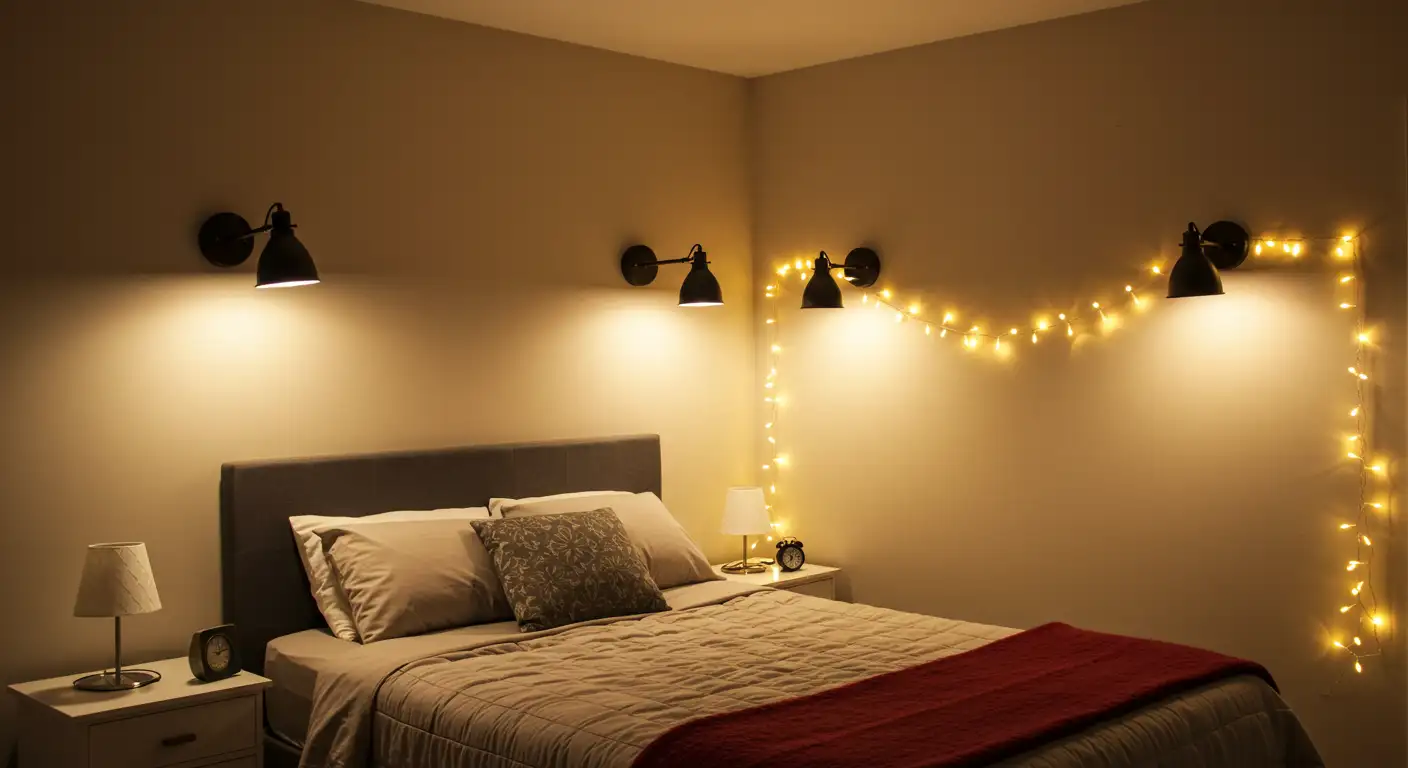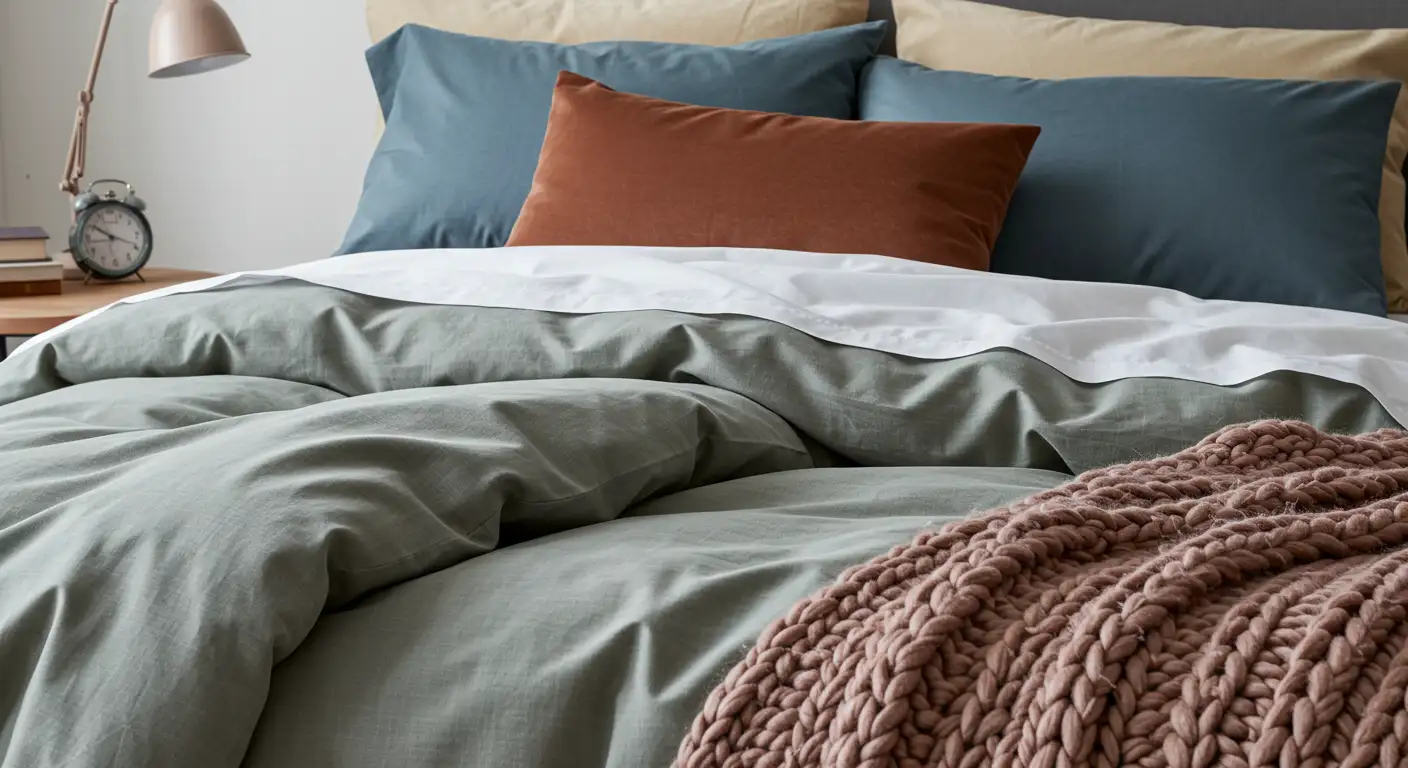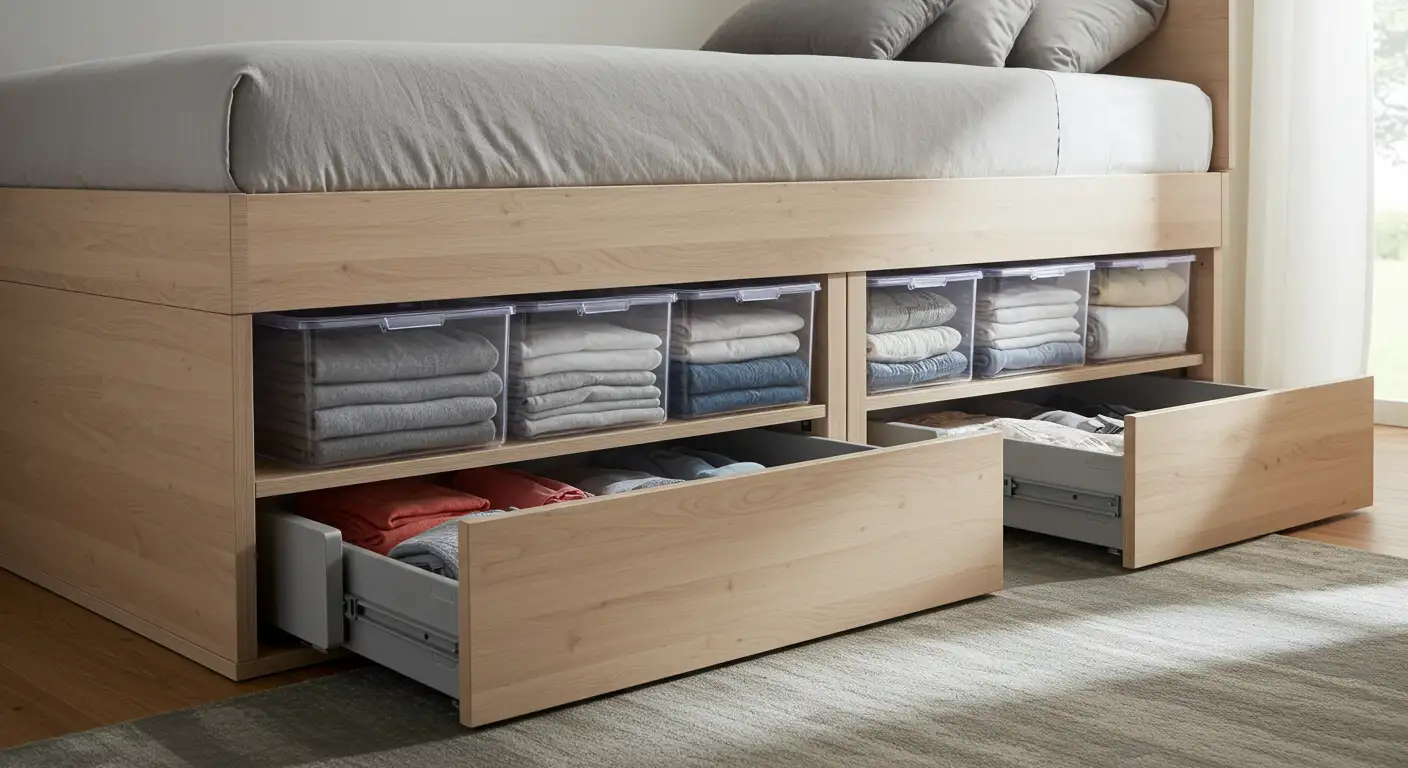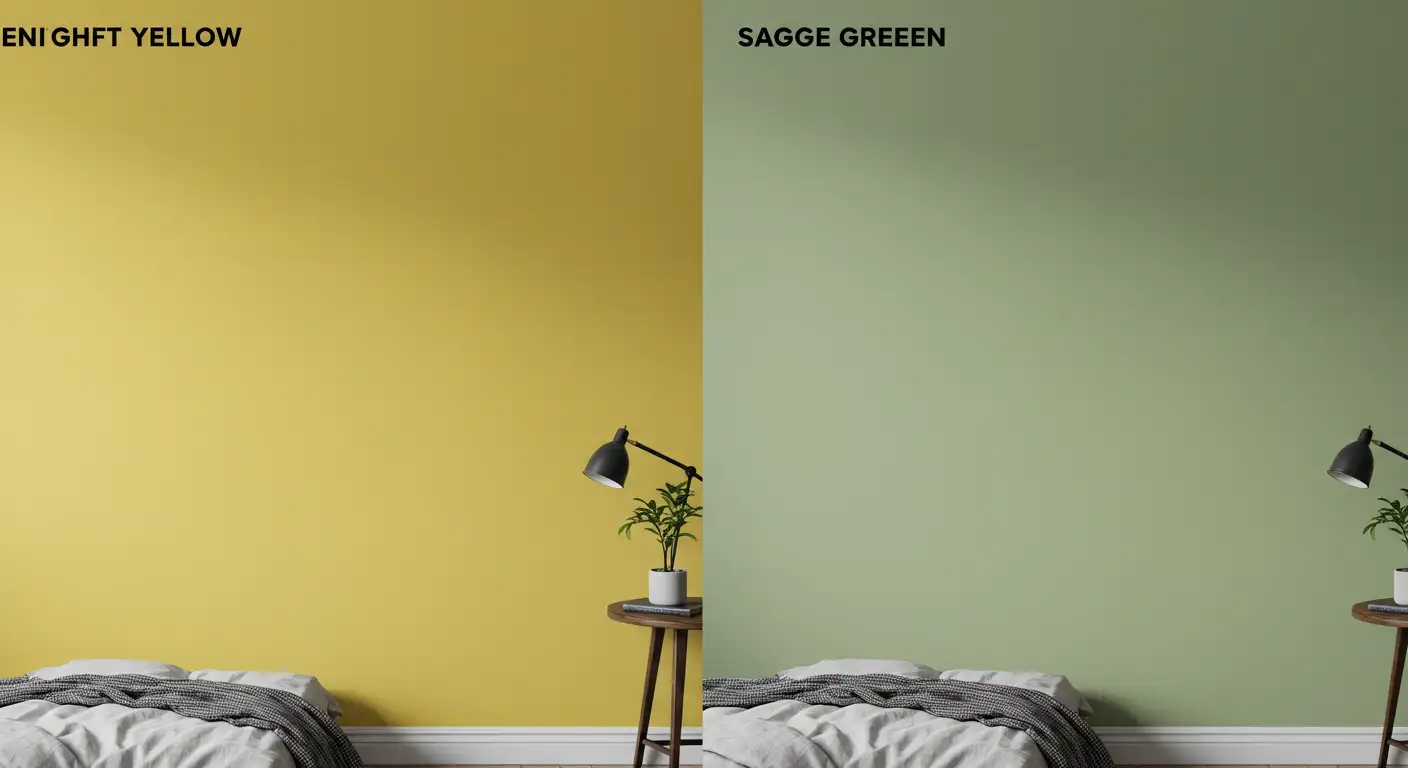It was 3 AM, and I was in my bedroom, surrounded by what could only be described as a complete mess. Half-assembled furniture was scattered across the floor, paint swatches covered every wall, and my trusty measuring tape wound around a pile of throw pillows.
I was an interior design writer who had just moved into a new apartment and didn’t want to create a magazine-worthy bedroom that would entail spending more money. Little did I know this late-night disaster would lead to some of the most practical bedroom design insights I’ve ever discovered.
Let me share the seven game-changing bedroom design hacks I learned through countless hours of experimentation, consultations with design experts, and, yes, more than a few mistakes.
7 Bedroom Design Dacks
- The Layered Lighting Revolution: The layered lighting concept transformed my understanding of bedroom ambiance. I used to think one overhead light was sufficient – rookie mistake. Everything changed when I interviewed Sarah Chen, a veteran interior designer with 15 years of experience. “Think of bedroom lighting in layers,” she explained. “Ambient lighting sets the mood, task lighting supports specific activities, and accent lighting adds drama and depth.”

Lighting Cost Breakdown:
- Bedside sconces: $45-75 each
- Floor lamp: $120
- String lights: $15
- Smart bulbs: $25-35 each
- Dimmer switches: $20-30
Pro tip: Properly place the task lighting, either reading lamps or sconces, at the shoulder level of the seated person so that they can provide perfect illumination and avoid glare.
The general illumination must produce between 2,000-4,000 lumens for a standard-sized bedroom, while the accent lighting that emphasizes the appearance alone can be dimmer at 400-800 lumens.
The Rule of Threes in Textile Layering My first attempt to style the bed was dumping all the cushions.
- I had on the bed – it was more of a mess than cozy. Through trial and error, I discovered the magic formula: three distinct textures in complementary colors. Interior stylist James Wong explains, “The human eye naturally groups things in threes. This principle creates visual interest while maintaining harmony.”
Textile Investment Guide:
- Base layer: Cotton duvet ($80-150)
- Middle layer: Velvet throw pillows ($25-40 each)
- Top layer: Chunky knit blanket ($50-70)
- Optional: Seasonal throws ($30-50)

Vertical Space Maximization: Living in a compact apartment taught me the value of vertical space. Installing floating shelves ($20-40 each) above my dresser initially seemed daunting, but they’ve become my favorite feature. “When designing small spaces, think cubic feet, not square feet,” advises spatial designer Lisa Martinez.
Vertical Storage Solutions:
- Floating shelves: Support up to 30 pounds each
- Wall-mounted organizers: $40-80
- Over-door storage: $25-50
- Corner shelving units: $60-120

The Mirror Placement Strategy: Mirror placement can dramatically affect room brightness and perceived space. After three different attempts, I found the sweet spot – placing a full-length mirror ($100-200) at a 45-degree angle where it reflects both natural light and greenery from the outside. According to lighting specialist Michael Chang, “A well-placed mirror can increase perceived light by up to 200% and make a room feel 50% larger.”
Mirror Placement Guidelines:
- Avoid facing beds directly.
- Position 57-65 inches from the floor (eye level)
- Maintain 24-36 inches distance from corners.
- Consider reflection views carefully.

Color Psychology in Practice: My most significant revelation came from understanding color psychology. Initially, I painted my bedroom a bright yellow, thinking it would energize my mornings. After two weeks of restless nights, I consulted with Dr. Maria Torres, a sleep specialist. She recommended switching to softer, cooler tones, explaining, “Certain colors can increase cortisol levels, disrupting natural sleep patterns.”
Color Impact Analysis:
- Blues: Reduce blood pressure and heart rate
- Greens: Improve reading speed and comprehension
- Neutrals: Promote relaxation and mental clarity
- Paint cost: $30-40 per gallon
- Professional painting: $200-400 per room

The Power of Negative Space: One of my most valuable lessons was learning when to stop adding elements. Creating intentional empty spaces makes a room feel more luxurious and calming. Design psychologist Dr. Sarah Miller explains, “Negative space gives the eye rest points and prevents cognitive overload, which is essential for a restful bedroom environment.”
Space Planning Guidelines:
- Maintain 30-36 inches of walking space.
- Keep 24 inches minimum between furniture pieces.
- Reserve 15-20% of visible wall space empty
- Allow 18 inches minimum nightstand clearance.
Smart Storage Solutions: My initial storage solution involved shoving everything under the bed—not exactly sophisticated. After researching space-saving techniques used in luxury hotels, I developed a comprehensive storage strategy. “Effective storage should be invisible but accessible,” notes professional organizer Rebecca Chen.
Storage Investment Breakdown:
- Bed risers: $20
- Under-bed containers: $30-50
- Drawer organizers: $15-25
- Vacuum storage bags: $20-30
- Closet system: $150-300
Implementation Strategy:
- Phase 1: Organize and analyze systems.
- Phase 2: Set up basic components (risers and containers).
- Phase 3: Install specialized organizers (drawer dividers).
- Phase 4: Keep and adjust the way it should be.
From this route, I’ve realized that effective bedroom design is not about obeying the strictest rules or spending money like water. Rather, it is about acquiring and mastering the simplest techniques and then applying them to your particular case and circumstances.
The most interesting finding? Little things like changing the furniture in a room so that it flows better or placing a plant here and there often change the atmosphere.
- Current Design Trends and Future Considerations:
- Environmental companies are being encouraged to design new furniture and articles using eco-friendly.
- resources (recycled textiles/bamboo)
- Smart lighting integration
- Biophilic design elements
- Multifunctional furniture pieces
- Air-purifying plants suitable for bedrooms
Budget Allocation Guide:
- Essential items: 50% of budget
- Decorative elements: 30% of budget
- Storage solutions: 20% of budget
- recommended total budget: $1,000-3,000
I started this project at midnight with a lot of chaos as I tried to work on the design of my home. It has since evolved into a continuing adventure in the journey of making a room that combines aesthetics and purpose.

Whether it is a studio or a master bedroom, you can use those little bits and pieces to turn your bedroom into a retreat—maybe don’t start your makeover at 3 AM as I did.
Remember that understanding the design process is different when a new need arises. Don’t be afraid to try out new things, make mistakes, and re-adjust your space as you recognize what works best for you.
The ideal bedroom is about being you, not just following trends—it’s about creating a space that unburdens you from the grind of this world and fills your heart with happiness.
FAQ
Q: What should my budget be for the complete bedroom reinvention?
A: Remodeling a bedroom can also be a good idea, but it will cost a bit of a buyout. A complete bedroom makeover ranges in price from $1,000 to $3,000. You can itemize it as follows: 50% for the bed, lighting, and storage, which are essential (for this price, of course), 30% for the decorative elements (the textiles and the artwork), and 20% for the storage solutions that come with it. However, if you are willing to make just a few changes, they can be very impactful, even with a smaller budget. For example, choose paint color ($30-$40/gallon) and light updates ($100-$200) as your priority changes.
Q: What is the best light setting for a bedroom?
A: A bedroom with perfect lighting should contain three essential types of lighting, that is, ambient lighting, task lighting, and accent lighting. The exact lumens of ambient lighting should be from 2000 to 4000 as it is the essential source of light in the room. Your task light should get 400-800 lumens and is better positioned to take up the reading/working area. Also, the accent light has to get from 200 to 400 lumens. Different types of lamps and the dimmer for lamps are the most used gadgets in the bedroom. Additionally, warm white bulbs (2700-3000K) could be used for a more comfortable environment.
Q: How can I increase the storage space in my tiny bedroom to the maximum of it?
A: To organize space in a small bedroom more efficiently, remember that vertical space can be used by walling shelves ($20-40 each), closet organizers ($150-300), and under-bed storage systems ($50-80). Frequent items need to be close at hand and, therefore, should be placed in areas that can be easily accessed. Also, use clear containers for easy visibility.
Q: Which colors help the best for sleeping?
A: As suggested by several neurologists working on sleep problems, the best colors for improving sleep quality are cool-toned ones, such as soft blues, gentle greens, and neutral grays. It is proven that they make the heart pump slower and the blood pressure relaxes, therefore reducing anxiety. Avoid loud and bright colors like red or yellow still in the main areas of the bedroom, as these are energizing colors that can increase cortisol levels, leading to bursts of energy and disturbance of sleep patterns.
Q: How do I create a luxury hotel in my bedroom?
A: You can make your bedroom look like a luxury hotel by buying first-class bedding (a cotton duvet from $80-150), bearing the points of layered lighting with dimmers, observing minimal surfaces, and sticking to the particular color scheme throughout. Besides curtains that prevent light from coming in, you can also put a soft area rug ($200-400) and a well-placed mirror to change the space’s look and make it seem even more luxurious and spacious.